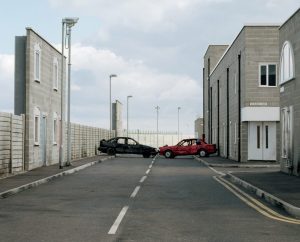Exercise 3: Public Order
How do Pickering’s images make you feel?
Is Public Order an effective use of documentary or is it misleading?

River Way Roadblock
Initially, they made me feel confused as if something was missing, not quite right. The obvious was people, but small hints soon began to materialise-no life makers, boarded up windows-the bare minimum is on display. Going through the series it becomes apparent that it’s covering certain scenarios-riot, barricades, signs of unrest.
By the end of it, I felt a bit ambivalent towards it. I definitely didn’t pick up the feelings the author of the course reader describes when they say- ‘ we’re left feeling uncomfortable and even unsafe; destruction and danger seem to lurk there’. In some respects, I just took them for what they are bar one of two e.g. River Way (Roadblock) and High Street (Barricade), where I reflected on them a bit more, began to think how police handle public order and train for it.

High Street Barricade
As a representation and documentation of a police training facility, it works well enough and shows different scenarios front and back. Taken at face value I’d say yes it works. Is it anything else? I’m not sure. Is it a clever piece of photography with layers of meaning? For me, there are not as many layers in this series as some I’ve seen from Paul Seawright (Sectarian Murders), Paul Graham (Troubled Land), Ineki Bergera (Empty Parking Spaces). Like any piece of work, it finds its way in the world and a narrative is built up around it. I read about it in an OCA degree course and about its meanings which lend it an air of authority and depth. Somehow, I feel I should buy into this and find layers of meanings, but I don’t- not deep ones, I did find myself thinking it would make a great place for a paint-balling afternoon.
Afterthought: Learning to read photographs is part of this course, and if you look at every series with that in mind, you do begin to unearth meanings. But whether I’m up for that every time is another matter, sometimes I just want a photograph to be more upfront, more direct.
When I read the following from the course reader ‘However what this clever piece of art documentary does is drip-feed scenarios into our subconscious. Why do these places exist? What do they do there? What else don’t we know about? It becomes disconcerting all over again but in a very different way. By using a visual strategy that makes us question and probe the work, Pickering enables us to challenge society norms that we take for granted or wouldn’t otherwise think about.’ – my feeling (at this point in time) is that this piece of work is being over analysed and you could interpret it in many different ways if you subscribe to the layers of meaning and are one of the lucky ones initiated in the art of reading photographs.
References
https://www.sarahpickering.co.uk/works/public-order/ (accessed 20/10/20210

